Recent development on climate conditions
Climate conditions

Climate change is one of the most pressing issues facing humanity in the 21st century. The Earth's climate is undergoing significant changes due to a variety of factors, including human activities and natural processes. In recent years, there have been several significant developments and events related to climate conditions that have garnered global attention. This essay will provide a comprehensive analysis of these recent happenings in climate conditions, focusing on key events, trends, and their implications.
I. Extreme Weather Events
One of the most conspicuous signs of climate change in recent years has been the increasing frequency and severity of extreme weather events. Heatwaves, hurricanes, wildfires, and floods have been on the rise globally, leading to devastating consequences for both human populations and ecosystems.
A. Heatwaves
Heatwaves have become more frequent and intense, affecting regions that were historically less susceptible to extreme heat. For instance, in June 2019, Europe experienced an unprecedented heatwave that shattered temperature records in several countries. France recorded its highest-ever temperature of 45.9°C (114.6°F). Such extreme heatwaves pose serious health risks, strain energy resources, and threaten agriculture and water supplies.
B. Hurricanes and Cyclones
The Atlantic hurricane season has seen an increase in the number of powerful storms in recent years. Hurricanes like Harvey (2017), Irma (2017), and Dorian (2019) left a trail of destruction in their wake. The warming of sea surface temperatures, a consequence of climate change, provides the energy needed for hurricanes to intensify rapidly, leading to more destructive storms.
C. Wildfires
Wildfires have become a global concern, with countries like Australia and the United States experiencing record-breaking fire seasons. The Australian bushfires of 2019-2020, also known as "Black Summer," led to the loss of 33 human lives and an estimated one billion animals. These fires are exacerbated by prolonged droughts, high temperatures, and dry vegetation, all linked to climate change.
D. Floods
Floods have affected numerous regions worldwide, causing widespread damage and displacement. In recent years, heavy rainfall and flooding events have struck parts of Asia, Africa, and even Europe. The increased frequency of extreme precipitation events can be attributed to a warmer atmosphere holding more moisture, leading to heavier rainfall.
II. Melting Ice and Rising Sea Levels
The polar ice caps and glaciers are melting at an alarming rate due to rising global temperatures. This phenomenon has significant implications for sea levels and coastal communities.
A. Arctic Ice Melt
The Arctic region is experiencing rapid ice loss, leading to a decline in sea ice extent and thickness. In September 2020, Arctic sea ice reached its second-lowest extent on record. The loss of Arctic ice not only contributes to rising sea levels but also disrupts ecosystems and accelerates global warming through the albedo effect, as ice reflects sunlight, while open water absorbs it.
B. Antarctic Ice Melt
Antarctica is losing ice mass at an accelerating rate. Studies indicate that the Antarctic ice sheet is losing nearly 250 billion metric tons of ice per year, contributing to sea level rise. The collapse of major ice shelves, such as the Larsen C in 2017, has raised concerns about the stability of the entire Antarctic ice sheet.
C. Rising Sea Levels
The melting ice and the thermal expansion of seawater due to warming have led to rising sea levels. Coastal cities and low-lying coastal regions are increasingly vulnerable to inundation. Small island nations, like the Maldives and Tuvalu, are at risk of being entirely submerged in the coming decades, leading to potential climate-induced migration and loss of territory.
III. Carbon Emissions and the Role of Nations
Global carbon emissions remain a central issue in the fight against climate change. Despite international agreements and commitments to reduce emissions, many nations continue to struggle to meet their targets.
A. Paris Agreement
The Paris Agreement, adopted in 2015, represents a landmark international effort to combat climate change. However, several key emitters, including the United States under the Trump administration, withdrew from the agreement, weakening its global impact. The return of the United States to the agreement under President Biden has been a positive development, but challenges in achieving emission reduction goals persist.
B. China's Emissions
China is the world's largest emitter of greenhouse gases, primarily due to its reliance on coal for energy production and rapid industrialization. In September 2020, China pledged to become carbon neutral by 2060, a significant commitment. Achieving this goal will require a fundamental shift in China's energy mix and industrial practices.
C. Renewable Energy Transition
Many nations are making strides in transitioning to renewable energy sources, such as solar and wind power. Investments in renewable energy infrastructure have increased significantly, and the cost of renewable technologies has continued to decline. However, the transition to renewable energy remains a complex challenge, particularly in regions heavily dependent on fossil fuels.
IV. Global Awareness and Activism
In recent years, there has been a surge in global awareness and activism surrounding climate change, driven by grassroots movements and youth-led initiatives.
A. Fridays for Future
The Fridays for Future movement, initiated by Swedish activist Greta Thunberg in 2018, has mobilized millions of young people worldwide to demand climate action. Their strikes and protests have put pressure on governments and corporations to take meaningful steps to reduce emissions and protect the planet.
B. Climate Strikes and Protests
Large-scale climate protests and strikes have occurred in major cities around the world. The Global Climate Strikes in September 2019 saw millions of people participate in climate marches, demanding climate action from their leaders.
C. Divestment Movements
Divestment campaigns have urged institutions, including universities and pension funds, to divest from fossil fuels. The movement aims to reduce the financial support for industries contributing to climate change.
V. The COVID-19 Pandemic and Climate
The COVID-19 pandemic, which emerged in late 2019, had profound effects on global economies and human behavior. While it led to temporary reductions in carbon emissions due to lockdowns and reduced economic activity, its long-term impact on climate change remains uncertain.
A. Short-Term Emission Reductions
During the initial lockdowns in early 2020, carbon emissions temporarily declined as industries slowed down, and transportation came to a halt. However, these reductions were short-lived, and emissions rebounded as economies reopened.
B. Green Recovery
Some nations have recognized the opportunity to pursue green recovery plans, investing in sustainable infrastructure and clean energy as part of their economic recovery from the pandemic. This approach aims to address both the economic and environmental challenges posed by the pandemic.
Conclusion
Recent developments in climate conditions paint a clear picture of the urgent need for climate action. The increase in extreme weather events, melting ice, rising sea levels, and ongoing carbon emissions all underscore the severity of the climate crisis. Nations, as well as grassroots movements and individuals, have a crucial role to play in mitigating climate change.
While progress has been made through international agreements like the Paris Agreement and the commitment of certain nations to carbon neutrality, much work remains to be done. The COVID-19 pandemic has shown the interconnectedness of global challenges and the need for coordinated responses.
The global awareness and activism surrounding climate change provide hope for a more sustainable future. However, it is essential to translate this awareness into concrete actions, including transitioning to clean energy sources, reducing emissions, and adapting to the changing climate.





Comments
There are no comments for this story
Be the first to respond and start the conversation.